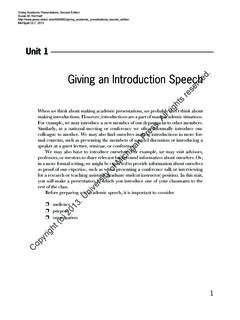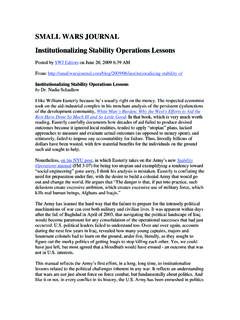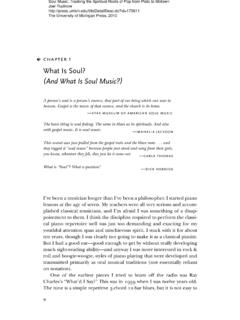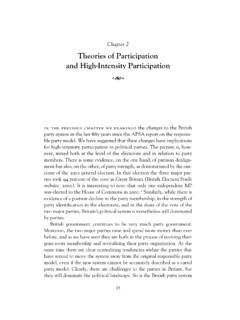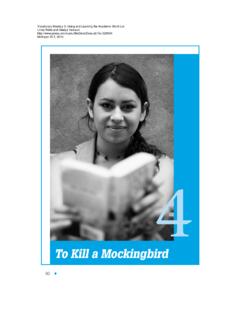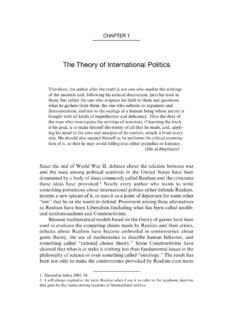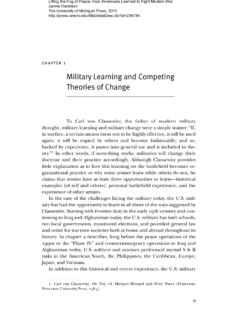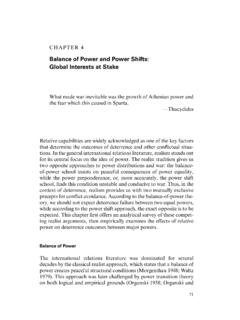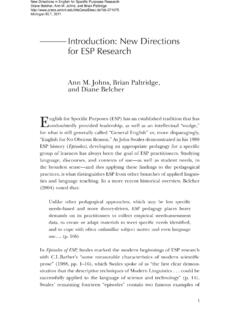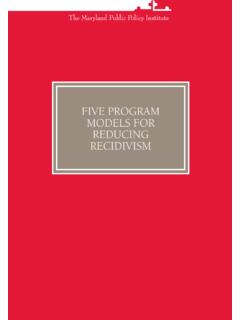Transcription of How the Poor Became Black - University of Michigan Press
1 Race and the Politics of Welfare Reform Sanford F. Schram, Joe Soss, and Richard C. Fording, Editors The University of Michigan Press , 2003. chapter 4. How the Poor Became Black The Racialization of American Poverty in the Mass Media martin gilens Race and poverty are now so closely entwined that it is hard to believe there was a time when discussions of American poverty neglected blacks altogether. African Americans have always been dispro- portionately poor, but Black poverty was ignored by white society throughout most of our history. In the following pages, I analyze over 40 years of news media cover- age of poverty in order to trace changes in racial images of the poor. I. nd that until the mid-1960s, poverty appeared overwhelmingly as a white problem in the national news media. But in a very brief period beginning in 1965, the media's portrayal of American poverty shifted dra- matically.
2 Although the true racial composition of the American poor remained stable, the face of poverty in the news media Became markedly darker between 1965 and 1967. The most obvious explanations for the news media's changing racial portrayal of the poor the civil rights movement and the urban riots of the mid-1960s played a role, but cannot account for the nature or tim- ing of the shifts in media images. Nor is this change in the media's por- trayal of poverty merely a re ection of the increasing visibility of African Americans in the news more broadly. Instead, the changing racial images of the poor in the mass media are 101. Race and the Politics of Welfare Reform Sanford F. Schram, Joe Soss, and Richard C. Fording, Editors The University of Michigan Press , 2003. Race and the Politics of Welfare Reform best understood as re ecting two very different processes that converged in the mid-1960s.
3 First, the stage was set by a series of historical changes and events that made Black poverty a less remote concern for white Americans. These included the migration of African Americans from the rural South to the urban North, the increasing representation of blacks among AFDC bene ciaries, the civil rights movement, and the riots of the mid-1960s. But these changes only created the environment in which racial portrayals of poverty were transformed. The proximate cause of that transformation was the shift in the moral tone of poverty coverage in the news. As news stories about the poor Became less sympathetic, the images of poor blacks in the news swelled. The association of African Americans with the undeserving poor is evident not only in the changing media coverage of poverty during the mid-1960s, but throughout the period studied.
4 From the early 1950s through the early 1990s, images of poor blacks increased when the tone of poverty stories Became more critical of the poor and decreased when coverage Became more sympathetic. Similarly, images of African Ameri- cans were most numerous in news stories about the least sympathetic subgroups of the poor. As I discuss below, these differences in the racial portrayal of the poor cannot be accounted for by true changes in the racial composition of the poverty population or by racial differences across subgroups of the poor. Rather, the media's tendency to associate African Americans with the undeserving poor re ects and reinforces . the centuries-old stereotype of blacks as lazy. Real-world changes in social, economic, and political conditions combined with existing racial stereotypes to shape the media's coverage of welfare and poverty over the past decades.
5 But this coverage has in turn shaped social, economic, and political conditions as states have dis- mantled and reformulated their welfare policies in response to the 1996. PRWORA reforms. American democracy is far from perfect. But public policies do re ect if inconsistently and incompletely the public's pref- erences (Monroe 1979; Page and Shapiro 1983; Wright, Erikson, and McIver 1987; Monroe and Gardner 1987; Shapiro and Jacobs 1989; Stim- son, Mackuen, and Erikson 1995). In the case of welfare, however, citi - zens' preferences have been shaped by media portrayals that exaggerate the extent to which poverty is a Black problem and that systematically associate African Americans with the least sympathetic subgroups of the poor. Other chapters in this volume ably document the many ways in which welfare reform has been infused with racial considerations and re ective of racial biases.
6 In this chapter, I show how distorted news cov- 102. Race and the Politics of Welfare Reform Sanford F. Schram, Joe Soss, and Richard C. Fording, Editors The University of Michigan Press , 2003. how the poor Became Black erage of poverty has helped to generate a citizenry that views welfare and poverty through a racial lens. African Americans: The Once-Invisible Poor The American public now associates poverty and welfare with blacks. But this was not always the case. The scienti c study of poverty in America began around the end of the nineteenth century. During this period social reformers and poverty experts made the rst systematic efforts to describe and analyze America's poor ( , Warner 1894; Hap- good 1902; Lee 1902; Hunter 1904; Hollander 1914). Racial distinctions were common in these works, but such distinctions usually referred to the various white European races such as the Irish, Italians, and Poles.
7 This early poverty literature had little or nothing to say about The Great Depression, of course, brought the topic of poverty to the forefront of public attention. But as the American economy faltered and poverty and unemployment increased, white writers and commentators remained oblivious to the sufferings of the Black The economy grew dramatically after the war, and living standards rose quickly. In contrast with the depression, poverty seemed like a dis- tant problem during the postwar years. Poverty was rediscovered, . however, in the 1960s. Stimulated by the publication of John Kenneth Galbraith's The Af uent Society (in 1958) and Michael Harrington's The Other America (in 1962), the American public and policymakers alike began once more to notice the poor. During the 1960 presidential cam- paign John Kennedy is said to have been shaken by the grinding poverty he saw in West Virginia, where a lack of both education and job oppor- tunities had trapped generations of poor whites in the primitive condi- tions of rural poverty (Patterson 1994, 126).
8 And early in his presidency Kennedy inaugurated a number of antipoverty programs focusing on juvenile delinquency, education and training programs for those lacking marketable skills, and federal assistance for depressed regions of the country. But the poverty programs of the early 1960s, and the popular images of the poor that went along with them, were just as pale in com- plexion as those of the turn of the century. Attention to poor blacks was still quite limited both in the mass media and, apparently, among Kennedy administration If there was a dominant image of poverty at this time, it was the white rural poor of the Appalachian coal elds. 103. Race and the Politics of Welfare Reform Sanford F. Schram, Joe Soss, and Richard C. Fording, Editors The University of Michigan Press , 2003. Race and the Politics of Welfare Reform Background Conditions for the Racialization of Poverty Popular images of poverty changed dramatically, however, in the mid- 1960s.
9 After centuries of obscurity, at least as far as white America was concerned, poor blacks came to dominate public thinking about poverty. Two decades-long changes helped to set the stage for the racialization . of popular images of the poor. The rst was the widespread migration of rural southern blacks to northern cities. At the turn of the twentieth cen- tury, over 90 percent of African Americans lived in the South, and three- quarters of all blacks resided in rural areas (Meier and Rudwick 1970, 213). Blacks had been leaving the South at a slow rate for decades, but Black out-migration from the South grew tremendously during the 1940s and 1950s before tapering off during the 1960s. As a consequence of this migration, African Americans, who only accounted for 2 percent of all northerners in 1910, comprised 7 percent by 1960, and, perhaps more importantly, made up 12 percent of the population in urban areas (Turner 1993, 249, 251).
10 As we'll see below, the racialization of public images of the poor occurred fairly suddenly and dramatically between 1965 and 1967. Clearly there is no simple connection between the growth of African American communities in northern cities and public perceptions of the poor as Black . Nevertheless, the growth of the Black population in the North was one link in a chain of events that led to the dramatic changes in how Americans thought about poverty. A second change that paved the way for the racialization of poverty images was the changing racial composition of AFDC, the nation's most conspicuous program to aid the poor. As established in 1935, the ADC. program (as it was then called) allowed individual states considerable discretion to determine both the formal rules governing ADC eligibility and the application of those rules.
